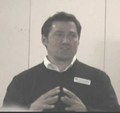GETTING AHEAD OF THE WAVE: Seminar #1 in Comox Valley Learning Lunch Series introduced this theme to underscore the passion and commitment of the local government players—“Call to Courage: Demonstrating the Regional Team Approach in the Comox Valley”
Note to Readers:
This article is the eighth in a series that progressively foreshadow and/or elaborate on learning outcomes for the 2009 Comox Valley Learning Lunch Seminar Series.
The first seven stories established expectations and set the stage for the first seminar, titled Understanding the Dynamics of Settlement Change. This Story #8 provides a record of the day:
- it highlights the defining moments,
- comments on the implications, and
- summarizes resulting action items.
This Story #8 is an abridged version of an article that is 10 pages in length. To read the complete article, click on this link to download a PDF version of Call to Courage: Demonstrating the Regional Team Approach in the Comox Valley.

Key Messages
The title for this Story #8, Call to Courage: Demonstrating the Regional Team Approach in the Comox Valley, synthesizes three key messages:
- the ‘call to courage’ by the organizing team underscores the passion and commitment of the local government players;
- through their actions, the Comox Valley local governments are already demonstrating what the ‘regional team approach’ looks like; and
- the Series spotlight is on working with existing legislation to achieve integrated outcomes.
This article emphasizes the relevance of a newly introduced phrase: Green Action Objectives. The inspiration is the paper by Susan Rutherford (of West Coast Environmental Law) which is titled Bill 27: Opportunities and Strategies for Green Action by BC Local Governments.
Understanding Settlement Change on the East Coast of Vancouver Island
The main focus of the article is on what drives settlement on the mid-Island region of Vancouver Island. Tim Pringle, Director of Special Programs for the Real Estate Foundation of British Columbia, presented the results of his market research that led to three three conclusions:
- T
 here is one market for large-scale real estate development projects in the mid-Island region, from Cobble Hill to Campbell River.
here is one market for large-scale real estate development projects in the mid-Island region, from Cobble Hill to Campbell River. - Communities have choices when considering development proposals – they need only accept ones that are aligned with community values, that is: the right development in the right place.
- A matrix-type Development Evaluation Tool has been developed to enable apples-with-apples comparisons of development proposals, and assess whether they provide Green Value.
To watch a YouTube video clip of Tim Pringle, click on Conclusions from the Research.

Comox Valley Can Pick and Choose
“The one market way-of-thinking resonated with those who participated in Seminar #1,” observes Geoff Garbutt, Executive Manager of Strategic and Long-Range Planning with the Comox Valley Regional District. “It makes sense that mid-Island communities have choices. Knowing this, it means mid-Island communities can establish expectations as to what we want and what we will accept from developers.”
 “Because it is one market, the Comox Valley can really differentiate itself with our strong environmental focus and our emphasis on quality of place. Because we can pick and choose, we can position the Comox Valley to be a region of choice for the right development in the right place.”
“Because it is one market, the Comox Valley can really differentiate itself with our strong environmental focus and our emphasis on quality of place. Because we can pick and choose, we can position the Comox Valley to be a region of choice for the right development in the right place.”
“An implicit message to the development community is that there is money to be made when green development is truly aligned with community values and regional goals.”
The Water Challenge
“Water is the underpinning of the community, and this is why an integrated approach to settlement and land development is essential for the Comox Valley,” stated Kevin Lorette, General Manager of the CVRD Property Services Branch, when he explained the multi-faceted ‘water challenge’.
 “Water is a key component for all the regional strategies that we are currently developing simultaneously. All will have to be integrated into one plan. At the core is growth – we are bringing these strategies together in 2010 to manage growth. We will be looking at all aspects of water.”
“Water is a key component for all the regional strategies that we are currently developing simultaneously. All will have to be integrated into one plan. At the core is growth – we are bringing these strategies together in 2010 to manage growth. We will be looking at all aspects of water.”
“When we move into the action phase, it will not be one organization doing it. This involves everybody. Job functions will be modified so that everyone has a role in implementation. If we all work together, we will be that much more effective.”
To Learn More:
Watch a YouTube video clip of Kevin Lorette explain The Regional Team Approach.
Integration Leads to Innovation
To provide seminar participants with an example of what integration looks like on the ground, Derek Richmond, Manager of Engineering with the City of Courtenay drew attention to a City project along Anderton and Cliff Avenues in the Old Orchard area of northwest Courtenay.
 “In a nutshell, an infrastructure replacement project evolved into a neighbourhood rehabilitation program,” stated Derek Richmond. “We began with a traditional infrastructure project in our minds: replace a pipe with a pipe. And then something amazing happened – we lifted ourselves out of the traditional silo mentality and we began to function as an integrated, inter-departmental team.”
“In a nutshell, an infrastructure replacement project evolved into a neighbourhood rehabilitation program,” stated Derek Richmond. “We began with a traditional infrastructure project in our minds: replace a pipe with a pipe. And then something amazing happened – we lifted ourselves out of the traditional silo mentality and we began to function as an integrated, inter-departmental team.”
“Through teamwork, a seemingly routine engineering project became the springboard for transforming the look-and-feel of an entire neighbourhood.”
Imagine What We Could Regionally:
“ If we can do this internally, imagine what we could do regionally,” added Kevin Lagan, the City’s Director of Operational Services. “Integrated planning is all about teamwork. There is no limit to what we can do once we open our minds to the opportunities that can result from partnerships and collaboration.”
If we can do this internally, imagine what we could do regionally,” added Kevin Lagan, the City’s Director of Operational Services. “Integrated planning is all about teamwork. There is no limit to what we can do once we open our minds to the opportunities that can result from partnerships and collaboration.”
Links to Previous Stories in this Series
Story #1: Comox Valley Regional District will host 2009 Learning Lunch Seminar Series
Story #2: CAVI releases program details for 2009 Vancouver Island Learning Lunch Seminar Series
Story #3: What Drives Settlement on the East Coast of Vancouver Island
Story #4: A Regional Perspective on Water Supply in the Comox Valley
Story #5: An Integrated Watershed Approach to Settlement Change
Story #6: The Comox Valley Learning Lunch Seminar Series is for Implementers
Story #7: Today’s Expectations are Tomorrow’s Standards in British Columbia


